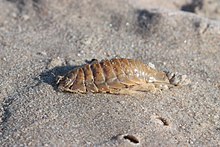
Saduria entomon is a benthic isopod crustacean of the family Chaetiliidae. It is distributed along the coasts of the Arctic Ocean and of the northern Pacific Ocean. It is also found in the brackish Baltic Sea, where it is considered a glacial relict. Moreover, it is present in a number of North European lakes, including Ladoga, Vänern and Vättern. It has been introduced into the Black Sea.

Sphaeromatidae is a family of isopods, often encountered on rocky shores and in shelf waters in temperate zones. The family includes almost 100 genera and 619 known marine species. Within these genera, there are groups that share distinctive morphologies; further research may reclassify these genus-groups as separate families.
Arubolana aruboides is a species of crustacean in the family Cirolanidae. It is endemic to Bermuda.
Curassanthura is a genus of isopod crustaceans in the family Leptanthuridae. It contains the following species:
Mexilana saluposi is a species of crustacean in the family Cirolanidae, the only species in the genus Mexilana. It is endemic to Mexico.
Onchotelson is a genus of isopod crustaceans in the family Phreatoicidae, which is endemic to Tasmania. It contains two species, both of which are listed as vulnerable on the IUCN Red List:
Nichollsia is a genus of isopod crustaceans from India. It comprises two species:

The Asellidae are a family of isopod crustaceans, one of the largest families of freshwater isopods, living in both epigean and hypogean habitats in North America and Europe. The family includes these genera:

Ligidium japonicum is a species of woodlouse found in moist forests in Japan. Individuals may live for up to two years and reach a length of 8 millimetres (0.31 in).
Iais is a genus of isopod crustaceans. Iais species are found in association with larger isopods of the family Sphaeromatidae, usually on the ventral surface of the larger animal, between the pereiopods and on the pleopods. They are native to Australasia and South America, although Iais californica and its host Sphaeroma quoyanum have invaded California, and I. californica was first described from Sausalito, California. Nine species are recognised:

The Idoteidae are a family of isopod crustaceans. It includes these genera:
Remasellus parvus, the swimming Florida cave isopod, is an isopod endemic to "4 caves in the Ochlockonee and Aucilla-Suwanee drainages of Florida", United States. It is the only species in the genus Remasellus.
The Calabozoidae are a family of isopod crustaceans, placed in its own suborder, Calabozoida or Calabozoidea. It comprises two genera, Calabazoa and Pongycarcina.

The Leptanthuridae are a family of isopod crustaceans, containing the following genera:
Hemioniscus balani, a species of isopod crustacean, is a widespread parasitic castrator of barnacle in the northern Atlantic Ocean. Its range extends from Norway to the Atlantic coast of France, and as far west as Massachusetts. It is also commonly found on the Pacific coast of North America; it is not known if the Pacific and Atlantic populations are the same species, or if the Pacific population exists following human-assisted introduction.

Chiridotea is a genus of isopod crustaceans in the family Chaetiliidae, containing the following species:

The Chaetiliidae are a family of isopod crustaceans in the suborder Valvifera, comprising these genera:

Agnaridae is a family of woodlice. They were formerly considered part of the Trachelipodidae, but were moved from that family to Porcellionidae in 1989, and then placed as a separate family in 2003.
The Entoniscidae are a family of marine isopod crustaceans in the suborder Cymothoida. Members of this family are parasites of brachyuran and anomuran crabs, living in their hosts' haemocoel. A small chitinised hole develops through the host's exoskeleton through which the isopod can communicate with the environment. The female isopod bears little resemblance to any free-living isopod, but the morphology of the larvae show their taxonomic affiliations.
Saduria sibirica is a benthic isopod crustacean of the family Chaetiliidae. It is widespread in Arctic marine water near the coasts of Siberia.









